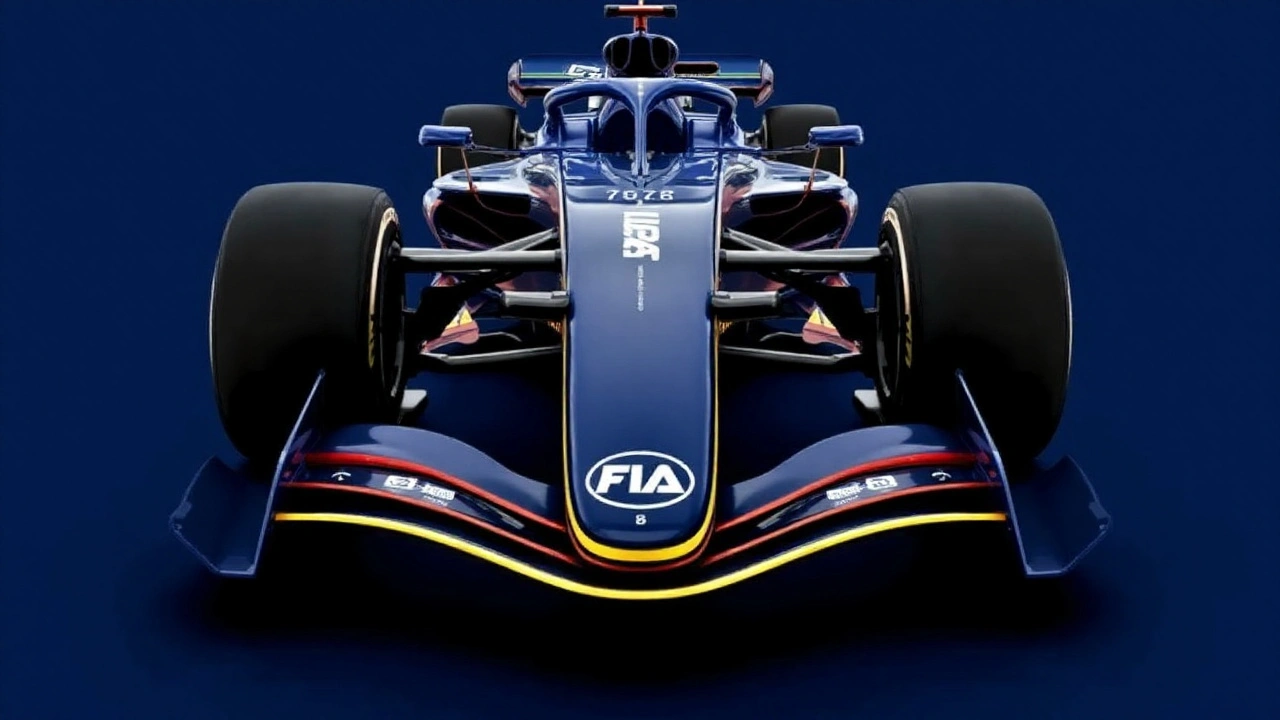FIA shrugs off lap-time worry: slower on paper, but built for better racing
Here’s the headline that got people talking: the 2026 Formula 1 cars will likely start out between one and two-and-a-half seconds slower per lap than today’s machines. That’s straight from FIA single-seater director Nikolas Tombazis, who also admits he’s a bit surprised by how obsessed everyone is with the stopwatch. His take is blunt: drivers will feel that difference, but from the grandstands and the couch, you probably won’t.
“There have been phases throughout the history of the sport where lap times have slowed,” Tombazis told Auto Motor und Sport. “I don’t think that’s harmed the sport… The driver feels the one and a half seconds. From the outside, you hardly notice it.” He also dismissed the idea that these cars might drift toward Formula 2 pace. That narrative doesn’t stack up with the data the FIA is seeing.
The point of 2026 isn’t raw speed at all costs. The target is a “nimble car” — smaller, lighter, easier to place, and more dependent on driver skill. On the numbers, the wheelbase shrinks by 200 mm to about 3400 mm. Width drops by 100 mm to 1900 mm. Minimum weight falls by 30 kg to 768 kg compared to the 2022 baseline. Less bulk should help in slow corners and on tighter tracks, where today’s cars can look unwieldy.
On the aero side, the rulebook cuts downforce by roughly 30% and slashes drag by about 55%. That’s a huge shift in how the air flows around the car. Top speeds could still be strong because of the lower drag, but cornering loads and tire strain should ease. The package also leans on active aerodynamics — movable front and rear wing elements that switch between a high-downforce mode for corners and a low-drag mode for straights. Instead of today’s DRS, drivers will manage this as part of the standard operating rhythm.
Then there’s the energy puzzle. The 2026 power unit splits output much more evenly between the internal combustion engine and electrical power. The MGU-H is gone, but the hybrid system gets a bigger role, with more harvesting and a meatier shove from the battery. That makes energy management central to racecraft, which is why the FIA is also introducing a Manual Override system. If you’re close enough to the car ahead, you’ll get a short, on-demand burst of extra electrical power to help attack — a smarter, more flexible replacement for the current drag-reduction crutch.
Plenty of fans heard “slower” and worried the show would suffer. Behind the scenes, the FIA has already tweaked the draft rules to keep that in check. Changes late last year lifted predicted performance by around two seconds in simulations, according to Tombazis. And that’s before teams start the inevitable development race. If F1 history tells us anything — from 2014’s hybrid reset to the 2022 ground-effect reboot — engineers will find speed quickly once they get their hands on stable regulations.
What will actually change on track — and why it could make racing better
The 2026 rulebook is a deep re-balance of car behavior rather than a cosmetic update. In simple terms, it trades a bit of peak cornering speed for more agility, clearer racecraft, and a power unit that fits F1’s push toward net-zero without neutering the thrill.
- Smaller footprint: shorter wheelbase and narrower width to help rotation, placement, and traffic management.
- Weight cut: a 30 kg drop from the 2022 benchmark to reduce inertia and tire stress.
- Aero reset: big drag reduction and less peak downforce to curb dirty air sensitivity and strain on tires.
- Active aero: driver-controlled modes for straights and corners instead of a simple “rear flap open/closed.”
- Energy boost: a Manual Override for the chaser to deploy extra electrical power when in range.
- Cleaner power: fully sustainable fuels paired with a higher electrical contribution.
Put all that together and you get a different style of fast. Expect straights where cars are slippery and quick, then a switch to higher downforce for braking and corners. Braking zones could be a touch longer than today thanks to lower downforce, which helps overtaking. And because the following car will have both aerodynamic tools and extra battery punch at hand, it won’t be stuck relying on just a flap and a prayer.
Tombazis’s bigger message is that racing quality beats a headline lap time. A one-to-two second swing isn’t the end of the world when the competitive spread on a normal weekend can be larger than that from front to back. If the pack stays closer and if drivers have real tools to pass, the show improves even if the stopwatch says “a bit slower.”
The sustainability piece is more than PR. The series is moving to fully sustainable fuels — synthetic or bio-sourced — designed to work in high-performance engines without competing with food supply. Add a much stronger electrical element and you’ve got a power unit that stays relevant to road-tech investment while still sounding and feeling like F1. That relevance matters. It’s part of why engine manufacturers are doubling down: Audi is joining the grid, Honda returns as a works supplier, and existing players like Mercedes, Ferrari, Renault and Red Bull Powertrains (in partnership with Ford) are plowing resources into the new ruleset.
Yes, there are open questions. Energy harvesting without the MGU-H has to be robust enough to avoid awkward lift-and-coast trains. The FIA says it has tuned the deployment and recovery windows to stop drivers from cruising in unusual places just to hit energy targets. The late-2024 tweaks were exactly about that: balancing harvesting capability, drag levels, and active aero behavior so drivers race, not game a spreadsheet.
Another unknown is how the smaller car will treat tires over a stint. Lower downforce and weight should reduce peak loads, but long-run performance depends on how teams cool brakes and batteries, how they shape the floor and diffuser within tighter limits, and how Pirelli dials compounds for the new load profile. Expect plenty of winter testing chatter about warm-up, graining, and how the energy boost changes attacking lines.
Track-to-track variation will also be a factor. On high-speed venues with long straights, the low-drag philosophy and active aero could mean eye-watering trap speeds even if ultimate lap time is down. On stop-start street tracks, the smaller footprint could help drivers thread gaps and commit to moves where today’s cars feel bulky. Some places might see a bigger delta to 2025 times; others, less so. The story won’t be uniform — and that’s fine.
What about reliability? Moving aero parts and a more complex hybrid system bring new failure modes. Teams will spend serious time hardening actuators for the wings, refining control software, and making sure battery temperatures don’t swing wildly in traffic. That’s the quiet grind of a regulation change: for every headline about horsepower, there’s a year of engineering on seals, cooling loops, and sensors to keep the car happy for two hours in dirty air.
If you’re wondering how quickly the field regains speed, look at F1’s muscle memory. After big resets, the first cars are a cautious first draft. Within months, teams trim mass, tighten packaging, and find downforce the wind tunnel missed. By mid-season two, lap records tend to start wobbling again. The FIA isn’t expecting 2026 to be any different. Tombazis even noted that the late regulatory updates already clawed back roughly two seconds in sims before anyone has bolted a real car together.
There’s also a competitive angle. A tighter set of bodywork rules and a more even power split could compress the power-unit gaps. If the engine side converges, the game shifts toward chassis efficiency, tire management, and how cleverly a driver uses energy and aero tools in combat. That’s where skill shows. It’s also where smaller teams have a shot to land a surprise with a clever concept, especially early in the cycle.
Fans love a benchmark, so here’s the honest one: expect the first version of the 2026 F1 cars to be a touch slower over a lap than the final evolutions we’ve got now. Expect them to look livelier in slow corners, less prone to getting stuck in traffic, and more varied in how drivers attack and defend. Expect straight-line games of chicken as both cars juggle energy and aero mode decisions. And expect the stopwatch to start losing the argument once the racing gets busy.
Tombazis’s surprise at the lap-time chatter makes sense when you remember the point of the reset. The FIA’s blueprint aims to keep the spectacle high while squaring the sustainability circle and keeping costs inside the cap. If the first few races run a little slower on paper but produce tighter fields and cleaner fights, that’s a trade most people will take. The stopwatch isn’t the only story here — and, if the FIA’s modeling holds up, it won’t be the most interesting one.






Ethan Smith
September 8, 2025 AT 17:44Active aero on the 2026 cars will let drivers toggle between high‑downforce corners and low‑drag straights without relying on DRS. That means we’ll see more genuine overtaking moves, not just a flap‑open hand‑wave. The lighter chassis also cuts inertia, so the cars can change direction faster and bite into traffic. Combined with a stronger hybrid split, energy management becomes a new tactical arena for the drivers.
Evelyn Monroig
September 13, 2025 AT 03:24What the FIA isn’t telling us is that the “slower lap times” excuse hides a deeper agenda to push manufacturers toward proprietary battery tech that only a handful of big players can afford. By trimming weight and cutting aero, they’re engineering a market lock‑in while pretending to care about racing spectacle. The whole “sustainability” line is just a smokescreen for tighter control over the supply chain.
Gerald Hornsby
September 17, 2025 AT 13:04The new rules feel like a fresh canvas for engineers – let’s see what crazy ideas emerge. 😏
Hina Tiwari
September 21, 2025 AT 22:44I get why fans are nervous, but i think the smaller cars will actually make the races feel more intimate. less bulk means drivers can thread gaps easier, and that could bring back some of the excitement we missed in recent years.
WILL WILLIAMS
September 26, 2025 AT 08:24Yo, this is the kind of shake‑up we needed! Smaller, nimbler beasts that dance through corners and blast down straights – it’s like watching a Formula 1 ballet mixed with a street‑racer’s sprint.
Barry Hall
September 30, 2025 AT 18:04Exactly, it’s gonna be wild.
abi rama
October 5, 2025 AT 03:44Even if some doubts swirl, the chance for fresh competition is real, and any push toward greener tech could open doors for new teams to join the grid.
Megan Riley
October 9, 2025 AT 13:24Absolutely!; the emphasis on hybrid power and active aero isn’t just a gimmick; it’s a practical step toward a more sustainable future; and it could level the playing field for newcomers!!!
Lester Focke
October 13, 2025 AT 23:04The forthcoming reduction in downforce represents a calculated re‑balancing of aerodynamic philosophy, privileging driver skill over raw mechanical grip. Such a paradigm shift aligns with historic precedents wherein regulatory refinements precipitated evolutionary performance gains.
Naveen Kumar Lokanatha
October 18, 2025 AT 08:44While i agree with the technical rationale, teams must also invest in robust actuator reliability and battery thermal management; otherwise the theoretical benefits may never materialise in race conditions.
Alastair Moreton
October 22, 2025 AT 18:24Honestly, this whole “new era” hype feels like a marketing ploy – give me a faster lap time or I’m bored.
Surya Shrestha
October 27, 2025 AT 03:04The FIA’s decision to cut the wheelbase by 200 mm and reduce overall weight by 30 kg is more than a simple dimensional tweak; it fundamentally alters the vehicle’s dynamic envelope. A shorter wheelbase reduces the polar moment of inertia, allowing the car to rotate quicker through low‑speed corners, which historically has been a weak point for the current generation. Coupled with a 30 % downforce reduction, the aero load distribution will be less aggressive, meaning tyre wear should decrease, potentially extending optimal performance windows. The active aerodynamic system, featuring driver‑controlled wing elements, reintroduces a manual component that could resurrect the strategic depth lost with static DRS configurations. By granting the driver agency over drag and downforce on a lap‑by‑lap basis, the FIA hopes to encourage more overtaking opportunities without relying on artificial wake‑reduction. The hybrid power unit’s new balance, with a larger electrical contribution and the removal of the MGU‑H, reshapes the energy recovery landscape, presenting engineers with novel challenges in thermal management and power delivery. Batteries will have to cope with more frequent high‑power bursts from the Manual Override system, demanding robust cooling solutions to avoid performance degradation. From a spectator perspective, the visual cue of wing morphing could add a layer of anticipation, as fans watch drivers decide when to switch modes. Moreover, the shift toward fully sustainable fuels aligns the sport with broader automotive industry trends, reinforcing F1’s relevance in the era of decarbonisation. Critics argue that slower lap times will diminish excitement, yet historical data shows that race quality often improves when aerodynamic sensitivity is reduced. The 2025‑2026 transition period will likely see a performance gap between early and late adopters, as teams iterate on packaging the new systems. By mid‑season, we can expect lap times to converge back toward, or even surpass, current benchmarks as engineering solutions mature. Finally, the regulatory framework’s emphasis on cost containment, through tighter component specifications, could level the competitive field, offering smaller outfits a realistic chance to contest for podiums. In sum, while the headline “slower laps” may attract headlines, the underlying technical evolution promises a richer, more driver‑centric spectacle. Thus, the 2026 rulebook represents not just a set of constraints, but a catalyst for innovative engineering.
Rahul kumar
October 31, 2025 AT 12:44From an engineerring standpoint, the reduced downforce means teams will lean heavily on suspension tuning to maintain mechanical grip, especially on bouncy street circuits where aero is less reliable. Also, keep an eye on the thermaly envelope of the new battery packs – they’ll run hotter than the 2022 units, so cooling ducts may need bigger cross‑sections.
mary oconnell
November 4, 2025 AT 22:24Oh great, another “nimble” package – basically a glorified go‑kart with a 750 kg power‑train and a side‑note of “sustainability”. Let’s just hope the “energy boost” isn’t just a glorified push‑button to hide the fact that we’re still chasing lap‑time percentages in a sea of buzzwords.
Michael Laffitte
November 9, 2025 AT 08:04When the lights go out, all the technical mumbo‑jumbo will melt away, and it’ll be the driver’s nerve that decides the outcome – pure, unfiltered adrenaline on a track that finally lets them breathe.
sahil jain
November 13, 2025 AT 17:44The interplay of driver skill and the new aero modes will likely produce races where strategic choices matter as much as raw speed, making each overtaking attempt feel earned.
Bruce Moncrieff
November 18, 2025 AT 03:24Is it possible that this regulatory shake‑up will usher in a new era of underdog success stories, where a clever chassis philosophy outweighs budget‑driven horsepower wars? The sport could finally see fresh narratives that keep fans hooked season after season.
Dee Boyd
November 22, 2025 AT 13:04While technocratic optimism fills the press releases, we must not ignore the ethical implications of pushing a sport toward ever‑greater energy consumption, even under the guise of “sustainable fuels”.